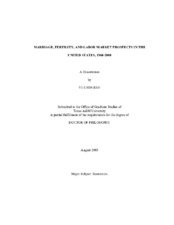| dc.contributor.advisor | Deere, Donald R. | |
| dc.creator | Kuo, Yu-Chen | |
| dc.date.accessioned | 2005-11-01T15:45:52Z | |
| dc.date.available | 2005-11-01T15:45:52Z | |
| dc.date.created | 2005-08 | |
| dc.date.issued | 2005-11-01 | |
| dc.identifier.uri | https://hdl.handle.net/1969.1/2561 | |
| dc.description.abstract | Over the past forty years a tremendous number of women have entered the labor
market, removing stay-home motherhood as the most dominant female occupation. The
linkage between the change in the labor market and change in family structure has drawn
a lot of attention from social scientists, and it is on this linkage that this analysis is
focused.
An essential dimension of this changing behavior is the sharp rise in out-ofwedlock
childbearing. The central issue of non-married motherhood is more related to
the diminishing willingness to marry than a changing attitude toward fertility. In a
setting where individuals choose marriage because of the gains from joint production of
child quality as well as the division of labor, the declining gains from specialization for
men influence potential spouse selection. Men and women with fewer labor market
prospects become less desirable, and consequently a marriage market with more positive
assortative mating will be observed.
The increase in female labor market participation is larger for highly-educated
women but the decrease in marriage rates is more characteristic of less-educated women
over this period. What drives these changes can be explained by using a simple economic theory, the fundamental concept of which is that couples with lower labor
market prospects also face lower gains from marriage because of the increases in femalemale
relative wages in the less-educated and black groups. A narrowing of the gap
between male and female wages would reduce the gains from division of labor and
lower the incentive to marry. In addition, when the marriage market becomes more
positively assorted, low educated men and women are less likely to marry each other.
Our empirical results indicate an increase in the homogeneity of wages between
spouses over this period regardless of whether we control for education. In particular,
black couples are more positively assorted than white couples although the trend
converges by the end of the century. We also show that the marriage market is tilted
towards better-educated men and women over the period. These findings are consistent
with the theory which explains why single motherhood is more concentrated among lesseducated
women. | en |
| dc.format.extent | 523665 bytes | en |
| dc.format.medium | electronic | en |
| dc.format.mimetype | application/pdf | |
| dc.language.iso | en_US | |
| dc.publisher | Texas A&M University | |
| dc.subject | Marriage | en |
| dc.subject | Fertility | en |
| dc.subject | Out-of-wedlock Childbearing | en |
| dc.subject | Assortative Mating | en |
| dc.subject | Demographic Economics | en |
| dc.title | Marriage, fertility, and labor market prospects in the United States, 1960-2000 | en |
| dc.type | Book | en |
| dc.type | Thesis | en |
| thesis.degree.department | Economics | en |
| thesis.degree.discipline | Economics | en |
| thesis.degree.grantor | Texas A&M University | en |
| thesis.degree.name | Doctor of Philosophy | en |
| thesis.degree.level | Doctoral | en |
| dc.contributor.committeeMember | Fossett, Mark | |
| dc.contributor.committeeMember | Li, Qi | |
| dc.contributor.committeeMember | Straub, John | |
| dc.type.genre | Electronic Dissertation | en |
| dc.type.material | text | en |
| dc.format.digitalOrigin | born digital | en |


